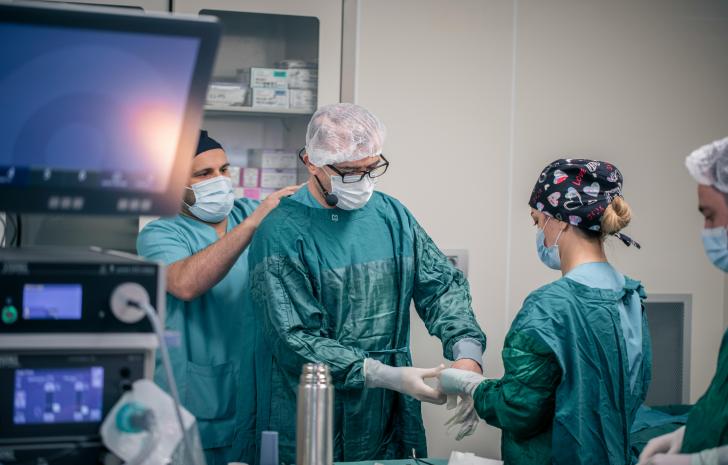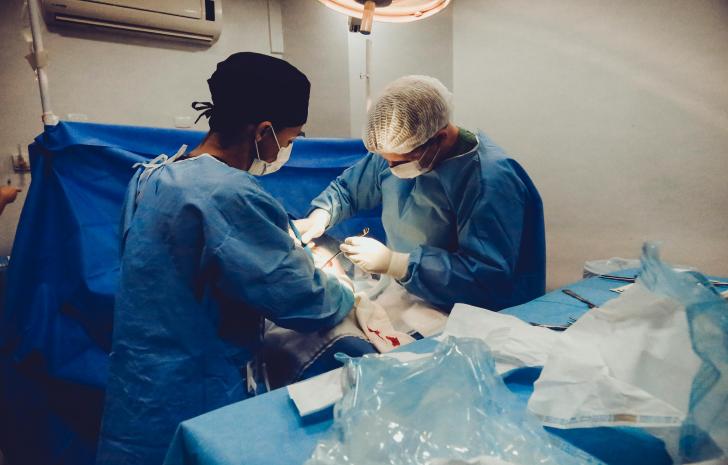Surgical error inspires doctor to champion the safety of all patients
- Home
- Surgical error inspires doctor to champion the safety of all patients

Surgical error inspires doctor to champion the safety of all patients
Dr. Peter Pisters is President & CEO of University Health Network (UHN), an academic health sciences centre in Toronto. UHN is an integrated health, research and education system that includes four hospital sites, Toronto General Hospital, Toronto Western Hospital, the Princess Margaret Cancer Centre, Toronto Rehabilitation Institute, and a school, the Michener Institute of Education at UHN. But he also sees himself as UHN's Chief Patient Safety Officer.
That's a duty he takes very seriously, fuelled by the painful memory of a single surgical sponge left behind in one of his patients.
It happened more than a decade ago, when Pisters was working as a busy surgeon at the University of Texas MD Anderson Cancer Center in Houston, but the feelings of fear, anger and frustration he felt that day remain fresh in his mind.
Pisters was leading what he describes as a highly complicated operation where a patient's diseased esophagus was removed and replaced with a transplanted segment of their colon. The surgery involved multiple teams and the procedure took nine hours to complete. Everything went well, but as the surgical team was finishing the standard sponge count, conducted before and after surgery, they came up one item short. Surgical sponges are squares of gauze used to sop up blood. During a long operation, doctors may use dozens of them inside a patient to control bleeding.
False counts are not uncommon in the bustle of an operating room, and Pisters ordered a recount. On that second check, it was believed that all sponges were accounted for.
"At that point in time the operation had been going on for a long time, the patient was cold, and I felt it was absolutely impossible that I could have left a sponge in the patient, and decided instead to let him go to the recovery room," Pisters recalls.
But there was still a trace of uncertainty in his mind. Just to be sure he ordered X-rays. When the images showed something had been left inside his patient, Pisters was stunned. Complicating matters, as he examined the scans, he found he could not identify with certainty what the item was.
"I realized at that moment that during my surgical training, during my fellowship training, in textbooks, in exams, I had never seen X-rays of foreign bodies that had been left inside patients. And as a result, I couldn't identify the foreign body, the material that I had left inside the patient."
Pisters immediately went to the patient's wife and told her something was not right, and that he suspected something had been left behind in her husband's body.
"As I left that first conversation I remember vividly walking down the hallway, with my head down thinking, 'how could this have happened, how am I going to figure this out, what am I going to do? What will this mean for me? Could this affect my family?" Pisters recalled.
"I had reached, in many ways, the pinnacle of my career. I'd been promoted to full professor after 10 years on the faculty. I was doing amazing, high-end technical surgery. We were experiencing incredible success as an organization in our group. And I was concerned that this would really adversely affect not just me personally and professionally, but would have wider implications on the organization. It could, in that environment, also extend into a world of litigation and a very complicated stream of events that's very unpleasant for everyone involved."
Over the next six hours, Pisters and his surgical fellows X-rayed every piece of equipment they had used in the operation that could possibly resemble the mystery object, until finally, at around 2 am, they concluded it was indeed a surgical sponge.
Pisters slept at the hospital that night and the next morning the patient was wheeled back into the operating room.
"I sat in the corner of the room on a stool and I watched my fellows re-open the abdomen. It took them just 20 minutes. They reached inside and pulled out the sponge. The whole thing was over in 30 minutes," he says.
"The patient was okay but that moment was like no other in my career. I felt horrible. I felt humiliated. I felt such grief. I could not believe that I could possibly commit an error like that. And as I began to think about this in greater detail, I began to realize that yes, I had committed an error, but multiple systems had failed this patient."
A surgeon made a mistake, two different sponge counts were done, and neither the physician nor the hospital had policies and protocols in place to deal with the conflicting information.
Pisters says he was personally changed by the experience and in later academic life, while studying patient safety at the Harvard School of Public Health, gained tremendous insights into the science of human error. When he moved into his leadership role at UHN in January 2015, Pisters saw it as a great opportunity to make a big difference in patient safety.
"Much of what we have to do today is to acknowledge and recognize that in health care we have had historically a culture of shame and blame, and a practice oftentimes of covering up our mistakes and moving on to the next patient," he says.
"We need to move past that, embrace principles and concepts of a just culture, and employ systems thinking to better understand the complexity of the work environment that we have in health care."
Pisters would like to see the Canadian health care system adopt safety approaches and principles that have been successfully deployed in other "high reliability" sectors like commercial aviation and chemical manufacturing.
"One of the biggest changes that we're bringing about at University Health Network is an approach that we call Caring Safely. It's a program that we have designed and rolled out in conjunction with the Sick Children's Hospital in Toronto. It really brings about a structured approach to patient safety, that begins with an effort to bring about a just culture, to bring about an approach that encourages a process of speaking up on safety, an approach that extends not only to patients but to employees and to workplace safety."
As the conversation around greater patient safety picks up steam across Canada, many health experts are pushing hospitals to become more open about reporting and publicly disclosing preventable errors. Pisters is one of them.
"I think patients and families do understand the complexity of medical care the way it's delivered today," he says. "They do understand that at times things don't go the way that we planned. And the candour and honesty that we demonstrate, even the uncertainty that we convey in times when we don't know, that in a paradoxical way builds trust with those patients and families."
Being involved in episodes of preventable medical error can take an emotional toll on health providers but Pisters believes the best remedy is for those providers to become safety champions within their own organizations.
"Those champions, especially when they are physicians, have tremendous influence in the health care environment in which they work. And when they move into leadership roles or they're fortunate to be in positions like mine, they can have profound influence on patient safety and this in turn can lead to saving thousands of lives."
Indeed, that's one of the reasons Pisters feels compelled to share his story. He thinks more health providers in the system need to stand up and be heard.
"All of us need to recognize that we have a role to play in patient safety and that we have an opportunity to create in Canada a transformational wave that really impacts how patients will be cared for in the future."


